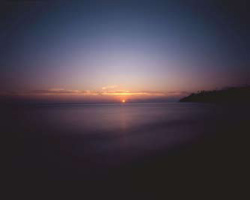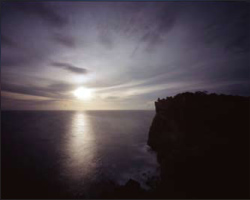Reviews
From PHP Real age Life+
 『#4031-Indonesia-Bali-Amed』
『#4031-Indonesia-Bali-Amed』2011-ピンホールPinhole
 『#4014-Indonesia-Bali-Pura Uluwatu』
『#4014-Indonesia-Bali-Pura Uluwatu』2011-Pinhole
Photography in pursuit of the connection between “heaven, earth and man” and the concept of “Yin and Yang”
Yoshiyasu Suzuka is an artist who has explored various methods of expression, such as photography, painting, and video. Of all these methods, however, photography has always been his main focus. When he was a student, he went to the U.S. supported by a Fulbright scholarship, and during his stay, self-portraits became the first photographic works he was mainly engaged in. The key concept behind his artwork originated from one simple question, “Who am I?” and through this photography he has been able to confirm and express his own identity.
The main tool for Suzuka’s art is the pinhole camera, which was the original prototype for modern-day cameras. To take pictures with this camera, light from the scene outside the lightproof camera box passes through a lens, which is actually just a small hole, and projects an inverted image onto photosensitive paper. The pinhole camera Suzuka uses has been customized through the use of modern scientific technology to prevent diffused reflection of light and uses built-in film rather than photosensitive paper. With this camera, the ability of photography to record time is expressed with more precision, higher quality, and in a more beautiful fashion.
The first subject of Suzuka’s pinhole photography was a sunrise at Cape Muroto in Shikoku. As his mother, who worshiped Kobo-Daishi or Kukai,, was sick at that time, he set up a pinhole camera at a sacred spot associated with Kukai, and, while waiting for the sunlight to come and enter the camera, prayed for his mother’s recovery. Since then, he has travelled to a number of coastal areas all around Japan to take photos of sunrises, sunsets, the breeze and the air, and extended his activities to include visits to other sacred sites around the world, including some in India, Nepal, and Bali.
On August 6, 2011, 65 years after the end of the war, he took a photo of the sun above the Hiroshima Peace Memorial (Genbaku Dome), at the exact time when the atomic bomb was dropped, with a prayer for “No more Hiroshimas.” His two most recent works were taken in Bali: one of a sunset at a sacred spot, Ulu Watu, and the other of a sunrise at Amed Beach.
When deciding where to travel for a shoot, Suzuka always bases his decisions on direction and destination by following the theories of I Ching and Yin-Yang and the Five Elements. This is an extension of his view of the world, which is the deep humbleness he feels in being allowed to live, and that things are decided by fate and connections. He realizes he can only live in the natural world and the universe through coincidental encounters, and, therefore, embraces the philosophy of “coincidence and consequence” when taking his pinhole photos.
The “Engi Mandala” series, one of Suzuka’s major works, is a collection of photos taken during visits to 88 sacred sites in Shikoku. His inspiration for this was the pilgrimage to these sites that was undertaken by his father after his mother’s death. The project itself involved a year-long pilgrimage and photo shoots, starting with a Polaroid portrait of a pilgrim he met at the first temple. This was followed by a portrait of a person he met on a visit to the second temple, holding the portrait of the previous person, which was a pattern he continued up to the 88th site. This project involving a chain of people resulted in the participation of approximately 2,000 people and 2,000 photos. This series is a true representation of his belief in a creativity fostered through connections that occur coincidentally.
Another major work of his is the “Gassho Mandala” series, a collection of photos featuring the hands of those he met through coincidental encounters in the act of prayer. His quest for harmonization between “coincidence and consequence” and between “Yin and Yang” in his photography still continues today.
Text - Makoto Otagaki,
art critic ⁄ professor at Osaka Seikei University
